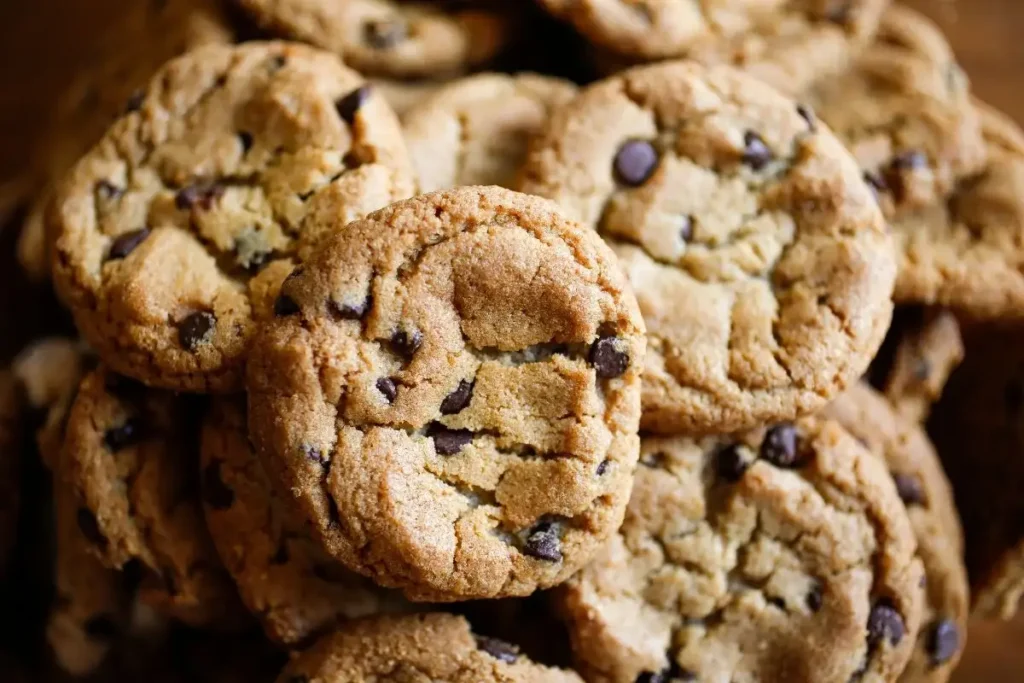
Why Are My Cookies Cakey And How To Fix Them in 5 Easy Ways
Tired of ending up with cookies that are more cake-like than chewy? No worries! We’ve got 5 simple tricks to nail that perfect chewy texture. Baking the ideal cookie is an art, and getting the texture spot-on can make a difference.
Whether it’s adjusting your ingredients, tweaking the baking time, or changing up your mixing technique, our easy tips will step up your cookie game.
With these proven methods, you can say goodbye to cakey cookies and welcome the delicious, melt-in-your-mouth treats you’ve been craving. Let’s dive into the world of cookie perfection and turn every batch into a scrumptious success!
Table of Contents
Toggle4 Common Causes of Cakey Cookies
Before fixing those cakey cookies, it’s important to understand why this happens in the first place. In this section, we’ll uncover four common reasons why your cookies turn out cakey.
Too Much-Rising Stuff
One big reason your cookies might turn cakey is using too much baking powder or baking soda. These things are great for making your cookies light, but if you go overboard, you’ll end up with a texture that’s more cake than cookie.
Stick to the recipe and try using less of these rising agents. It can change the game, finding that sweet spot between fluffiness and chewiness.
Picking the Wrong Flour
The kind of flour you pick makes a huge difference in your cookie’s texture. Cake flour, with its fine texture and less protein, can make cookies too cakey.
Go for all-purpose flour – it’s got the right balance of protein and texture to level up your baking. Get to know how flour works in giving structure and try different types until you get the chewiness you want.
Mixing Too Much
Mixing your cookie dough too much can throw a wrench in your plans. Too much mixing adds too much air, giving you a puffy, cake-like cookie. Beat your ingredients until they just come together, and don’t overdo it. If you find yourself with overmixed dough, gently mix in a bit more flour to get back that perfect texture without messing up the taste.
Not Enough Fat or Too Much
Getting the perfect cookie texture is all about finding the right balance between fat and flour. Too much fat and your cookies will spread too much; too little and they’ll end up dry and cakey. Measure your fats right and experiment until you find that perfect fat-to-flour ratio.
And watch out for the temperature of your fats – using overly soft or melted butter can make your cookies more cake-like. Find that sweet spot, and your cookies will be soft and chewy on the inside with a delicious exterior.
In the next sections, we’ll get into practical solutions for these problems, walking you through the exact steps to fix and prevent cakey cookies.

How to Fix Cakey Cookies in 5 Easy Ways
You’ve figured out the secrets of cakey cookies, and now it’s time to turn your baking blunders into a chewy masterpiece. Don’t worry; we’ve got you covered with five simple and practical ways to solve those cakey issues and up your cookie game.
1. Precision in Measurement Matters
The foundation of any successful baking endeavor lies in precise measurements. Inaccuracies in measuring ingredients can throw off the delicate balance of your cookie recipe, leading to an undesired cakey texture. Invest in reliable measuring tools and follow your recipe meticulously.
Pay special attention to flour, sugar, and leavening agents. Even a slight miscalculation can impact the outcome, so take the time to measure with care.
2. Temperature Tricks for the Perfect Dough
The temperature of your cookie dough plays a pivotal role in determining its final texture. Experiment with chilling or warming your dough based on the result you desire. If you prefer thicker, chewier cookies, refrigerate the dough for at least an hour before baking. This allows the fats in the dough to solidify, resulting in less spread during baking.
On the other hand, if you’re aiming for thinner cookies, let the dough come to room temperature before placing it in the oven. Finding the right temperature balance can make a significant difference in achieving your ideal cookie texture.
3. Ingredient Insights for Chewier Cookies
Understanding the role of each ingredient in your cookie recipe is essential for achieving the desired texture. Opt for all-purpose flour instead of cake flour, as the latter contributes to a cakey consistency.
Additionally, consider reducing the amount of leavening agents like baking powder. These adjustments can result in a chewier and more satisfying cookie. Experiment with different ratios until you strike the perfect balance that aligns with your taste preferences.
4. Adjust the Baking Time and Temperature
The duration and temperature at which you bake your cookies can greatly influence their texture. If you find your cookies consistently turning out cakey, try reducing the baking time and temperature slightly. Keep a close eye on your oven, as even a minute can make a difference.
This adjustment allows the cookies to retain more moisture, preventing them from becoming overly cake-like. Remember, the goal is to achieve that perfect balance between a golden exterior and a soft, chewy interior.
5. Experiment with Mix-ins for Added Moisture
Sometimes, introducing additional moisture to your cookie dough can counteract a cakey texture. Experiment with mix-ins like chocolate chips, chopped nuts, or dried fruit.
These additions not only enhance the flavor but also contribute moisture to the dough, resulting in a more desirable texture. Be mindful not to overmix the dough, as this can lead to a tougher cookie. Instead, gently fold in your chosen mix-ins until evenly distributed.

What Makes Cookies Chewy vs Cakey?
The age-old debate of chewy versus cakey cookies often leaves bakers perplexed. Understanding the science behind these textures is key to achieving your desired outcome in the baking arena.
Factors Influencing Chewiness:
- Fat Content: Cookies with a higher fat content tend to be chewier. Fats coat the proteins in flour, inhibiting gluten formation and resulting in a softer texture. Opt for recipes with slightly more butter or oil for that satisfying chew.
- Sugar Syrupiness: Sugar plays a dual role in cookies. Beyond sweetness, it also contributes to chewiness. When heated, sugar caramelizes and adds moisture to the dough, enhancing the chewy factor. Brown sugar, with its molasses content, is particularly effective in creating a chewy texture.
Ingredients That Lead to Cakey Texture:
- Leavening Agents: Baking powder and baking soda, when overused, introduce excessive air into the dough, causing cookies to rise and adopt a cake-like consistency. Be mindful of the leavening agent quantities for the desired outcome.
- Cake Flour Selection: Opting for cake flour, with its lower protein content, can make cookies more delicate and cakey. Choosing all-purpose flour strikes a balance, providing structure without compromising on chewiness.

8 Tips to Keep Your Cookies Chewy Instead of Cakey
Getting the perfect texture for your cookies means avoiding the dreaded spongy feel that can turn your tasty treats into cake-like letdowns. Follow these essential tips to make sure your cookies stay perfectly chewy:
- Watch Your Flour: Using too much flour is often the culprit behind spongy cookies. Be careful when measuring your flour, and try using different types for varying textures.
- Sugar Smart: Sugar plays a crucial role in cookie texture. Find the right balance; too much can make your cookies cakey. Experiment with brown sugar for added moisture and chewiness.
- Butter Basics: The type and amount of butter you use are key to the texture. Choose the right butter, and don’t go overboard. Too much butter can make your cookies cake-like. Find the perfect balance for that ideal chewiness.
- Egg Expertise: Eggs bind the cookie dough, but too many can lead to sponginess. Stick to the recipe for the number of eggs, and try alternative binders like applesauce or yogurt.
- Watch the Leavening Agents: Baking soda and baking powder give cookies lift, but too much can make them too spongy. Measure carefully and consider reducing these ingredients for a chewier texture.
- Chill Out: Properly chilling your cookie dough can make a big difference. It helps control spread and adds to a chewy texture. Experiment with different chilling times to find what works best for your recipe.
- Temperature Check: Keep a close eye on your oven temperature. Too high a temperature can make your cookies cakey. Use an oven thermometer for accuracy and consistency.
- Mixing Skills: How you mix your dough affects its texture. Overmixing can introduce too much air, leading to sponginess. Mix until just combined for the best chewiness.
Frequently Asked Questions (FAQS)
What makes cookies chewy, baking soda, or baking powder?
Both baking soda and baking powder can contribute to cookie chewiness. However, using too much of either can lead to a cakey texture. For optimal chewiness, it’s essential to balance the leavening agents, prioritize brown sugar, and avoid overmixing the dough for the desired consistency.
What makes a cookie chewy and not cakey?
Chewy cookies are achieved by using a higher ratio of brown sugar to white sugar, incorporating melted butter, and reducing the leavening agent. This creates a denser dough that spreads less during baking, resulting in a chewier, more satisfying texture.
How do you fix cookies that are too cake-like?
To fix overly cakey cookies, try reducing the amount of baking powder or baking soda, use more brown sugar than white, and avoid overmixing the dough. Additionally, chilling the dough before baking can help prevent excessive spreading and promote a chewier texture.
Why did my cookies come out cakey?
Cakey cookies may result from using too much leavening agent (baking powder or baking soda) or overmixing the dough. Ensure accurate ingredient measurements, use the right flour, and consider adjusting the ratio of sugars to achieve the desired chewy texture.
Why Are My Cookies Cakey And How To Fix Them | Final Thoughts
In conclusion, making the perfect chewy cookie is like an art project that requires careful attention and knowing the science behind each ingredient.
Whether it’s measuring precisely or playing around with temperature, ingredient ratios, and add-ins, our 5 simple tricks can turn your baking mistakes into chewy masterpieces.
Steer clear of common problems like using too much leavening agents or picking the wrong flour. Embrace the delicate balance of fat and flour, and be mindful of the baking time and temperature.
By following these tips and keeping an eye on the important factors, you’ll say goodbye to cakey cookies and welcome batches of delicious, melt-in-your-mouth treats. Happy baking!
Lindsey Mackenzie
About me
Hi there! I’m Lindsey Mackenzie, the founder of Bake Smartly. Baking has been my passion since childhood, growing up in my father’s bakery. With Bake Smartly, I’m excited to share my love for all things sweet and savory. Join me on this delicious journey as we whip up scrumptious treats and sprinkle joy into every bite!






